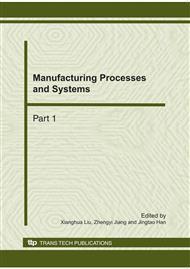[1]
A.P. Alivisatos: Science Vol. 271 (1996), p.933.
Google Scholar
[2]
T. Hyeon: Chem. Commun. Vol. 8 (2003), p.927.
Google Scholar
[3]
X. Ren, D. Chen and F. Tang: J. Phys. Chem. B Vol. 109 (2005), p.15803.
Google Scholar
[4]
J. Gao, Y. Qi, W. Yang, X. Guo, S. Li and X. Li: Mater. Chem. Phys. Vol. 82 (2003), p.602.
Google Scholar
[5]
N.Y. Xia, J.Y. Xiong, B. Lim and S.E. Skrabalak: Angew. Chem. Int. Ed. Vol. 48 (2009), p.60.
Google Scholar
[6]
L. Manna, E.C. Scher and A.P. Alivisatos: J. Am. Chem. Soc. Vol. 122 (2000), p.12700.
Google Scholar
[7]
X.G. Peng, L. Manna, W.D. Yang, J. Wickham, E.C. Scher, A. Kadavanich and A.P. Alivisatos: Nature Vol. 404 (2000), p.59.
DOI: 10.1038/35003535
Google Scholar
[8]
Q. Song and Z.J. Zhang: J. Am. Chem. Soc. Vol. 126 (2004), p.6164.
Google Scholar
[9]
D. Yu and V.W. Yam: J. Am. Chem. Soc. Vol. 126 (2004), p.13200.
Google Scholar
[10]
Y. Khalavka, J. Becker and C. Sonnichsen: J. Am. Chem. Soc. Vol. 131 (2009), p.1871.
Google Scholar
[11]
Y.P. Sukhorukov, N.N. Loshkareva, A.A. Samokhvalov, S.V. Naumov, A.S. Moskvin and A.S. Ovchinnikov: J. Magn. Magn. Mater. Vol. 183 (1998), p.356.
Google Scholar
[12]
P.C. Dai, H.A. Mook, G. Aeppli, S.M. Hayden and F. Dogan: Nature, Vol. 406 (2000), p.965.
Google Scholar
[13]
M. Frietsch, F. Zudock, J. Goschnick and M. Bruns: Sensor. Actuat. B Vol. 65 (2000), p.379.
Google Scholar
[14]
C.L. Carnes and K.J. Klabunde: J. Mol. Catal. A Vol. 194 (2003), p.227.
Google Scholar
[15]
B. Liu and H.C. Zeng: J. Am. Chem. Soc. Vol. 126 (2004), p.8124.
Google Scholar
[16]
G.H. Du and G.V. Tendeloo: Chem. Phys. Lett. Vol. 393 (2004), p.64.
Google Scholar
[17]
Y. Chang, J.J. Teo and H.C. Zeng: Langmuir Vol. 21 (2005), p.1074.
Google Scholar
[18]
R. Yang and L. Gao: Solid State Commun. Vol. 134 (2005), p.729.
Google Scholar
[19]
J.W. Zhu, H.P. Bi, Y.P. Wang, X. Wang, X.J. Yang and L.D. Lu: Mater. Chem. Phys. Vol. 109 (2008), p.34.
Google Scholar
[20]
Y.G. Sun and Y.N. Xia: J. Am. Chem. Soc. Vol. 126 (2004), p.3892.
Google Scholar
[21]
J. Chen, T. Herricks, M. Geissler and Y.N. Xia: J. Am. Chem. Soc. Vol. 126 (2004), p.10854.
Google Scholar
[22]
J.W. Zhu, Y.P. Wang, X. Wang, X.J. Yang and L.D. Lu: Powder Technol. Vol. 181 (2008), p.249.
Google Scholar
[23]
J.W. Zhu, G.Y. Zeng, F.D. Nie , X.M. Xu, S. Chen, Q.F. Han and X. Wang: Nanoscale, Vol. 2 (2010), p.988.
Google Scholar
[24]
Y G. Sun and Y.N. Xia: Adv. Mater. Vol. 14 (2002), p.833.
Google Scholar
[25]
J.W. Zhu, D. Li, H.Q. Chen, X.J. Yang, L.D. Lu and X. Wang: Mater. Lett. Vol. 58 (2004), p.3324.
Google Scholar


